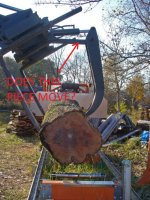I think you must have an error in your math. If we assume ID = 38 x 46" for the standard 40 x 48 inch totes, and you manage to cut your wood to fit without even 1/4" gaps (like Tetris-perfect), your best case 0.52 cords while keeping the total height at the 6 feet you had mentioned early. In reality, given your wood is probably not of a length that perfectly fills the tote, it's probably a bit under 0.50 cord.
Another indicator these are not 1.4 cords per bin. Check the cord weight of firewood, your 2700 lb. loader would get 1.4 cords of most species off the ground. Figure nearly 5000 lb. per cord for green oak, or 3600 lb. after drying. Your estimated 1.4 cords per bin would be 5000 to 7000 lb. per bin.
In any case, my tractor (JD 3033R) is too light to move that kind of weight on the loader, so not relevant to the design of this particular thumb. If I have to move something anywhere near that heavy, it'll be on the 3-point!


